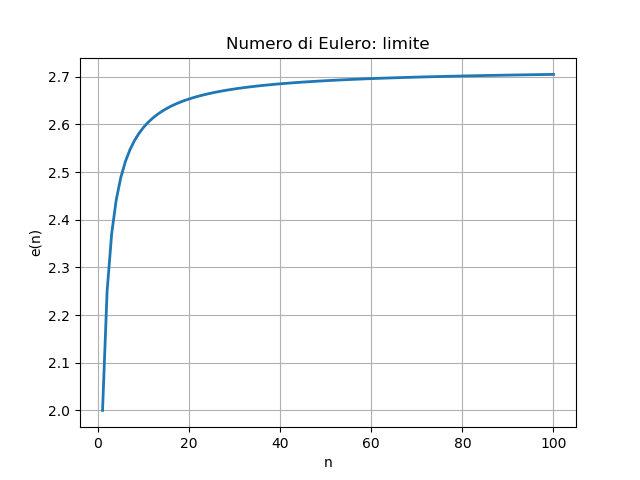Il limite notevole: ![]()
PASSI=100
for n in range(1,PASSI+1):
en=(1+1/n)**n
print("%3d | %.10f" %(n, en))
1 | 2.0000000000
2 | 2.2500000000
3 | 2.3703703704
4 | 2.4414062500
5 | 2.4883200000
... | ...
100 | 2.7048138294

import matplotlib.pyplot as plt
PASSI=100
N=[]
E=[]
for n in range(1, PASSI+1):
en=(1+1/n)**n
print("%3d | %.10f" %(n, en))
N.append(n)
E.append(en)
plt.grid()
plt.plot(N,E, linewidth="2")
plt.title("Numero di Eulero: limite")
plt.xlabel("n")
plt.ylabel("e(n)")
plt.show()
fractions
Ottieni una successione di frazioni che converge al numero di Eulero!
import fractions
def f(n):
x=fractions.Fraction(1, n)
return (1+x)**n
PASSI=10
for n in range(1,PASSI+1):
en=f(n)
print("%2d | %23s | %.15f" %(n, en, en))
_1 | 2 | 2.000000000000000
2 | 9/4 | 2.250000000000000
3 | 64/27 | 2.370370370370370
4 | 625/256 | 2.441406250000000
5 | 7776/3125 | 2.488320000000000
6 | 117649/46656 | 2.521626371742113
7 | 2097152/823543 | 2.546499697040713
8 | 43046721/16777216 | 2.565784513950348
9 | 1000000000/387420489 | 2.581174791713197
10 | 25937424601/10000000000 | 2.593742460100000